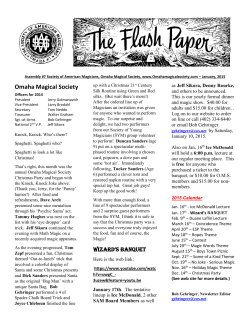
Origami-inspired Design of a Deployable and Collapsible Spherical
Origami-inspired Design of a Deployable and Collapsible Spherical Device Intended for Ablation Therapy Michelle Cho, Hope Lee, Jinda Zhuang, Professor Y. Sungtaek Ju Department of Mechanical and Aerospace Engineering, University of California – Los Angeles \ Space-saving instruments can facilitate certain sensitive procedures Parts are modified several times to fit original requirements Objective: To design a deployable structure that would aid in minimally-invasive operations, particularly ablation therapy, resulting in less bleeding, shorter recovery time, and smaller incision size for the patient First Approach: Expandable and Collapsible Folded Petal Structure Ablation therapy: A procedure involving the removal of abnormal tissues that surface due to certain conditions http://www.nature.com/nrcardio/journal/v10/n2/full/nrcardio.2012.198.html Approach process mapped for designing and creating structure Requirements: • Easily expandable using balloon inflation • Self-collapsible • Smooth surface Design Requirements Scale Down Original Origami Magic Ball and Petal Structure Create Prototype Second Approach: Structure with Alternation between Magic Ball Model and Folded Petals • Strips of the Magic Ball were used along with measured petals, which were folded with an alternation of mountain and valley folds • Flaws: Petals separated from each other even though overall structure was connected; the entire surface was not smooth Final Approach: Overlapping Petal Surface Over a Complete Magic Ball Structure • Measured, overlapping petals used to cover a Magic Ball in collapsed form • Petals calculated to expand along with the Magic Ball in order to form the smooth surface of a sphere • Meets requirements Fail Modify Structures Test Design Succeed Efficiency of designs measured by material usage, volume, and surface area Design Magic Ball and petals appropriate for an origami-inspired model Origami Expansion: Origami expansion has recently started being used to create more flexible First Approach Second Approach Final Approach (Prototype) Volume (cubic inches) devices, including solar panels and robots. Engineers mostly focus on different types of tessellation folds, such as the Miura folding pattern, because of their great levels of flexibility and their rigid quality, meaning they include only straight creases and flat planes. The original inspiration of design was the Magic Ball, a Miura folding structure. This model was used to provide the basic structure for the final design. http://how-to-make-origami-magic-ball.blogspot.com/ Replication of Spherical Surface with Petals: Demaine et al. "Wrapping Spheres with Flat Paper." Computational Geometry 42.8 (2009): 748-57. Web.) 30 171.64 318.08 636.16 Surface Area Compression Volumetric Expansion 25 20 15 10 5 0 Although the final design meets all the requirements, it requires the largest amount of material. Cylinder Structure Sphere 350 350 300 300 250 250 200 200 150 150 100 100 5050 0 0 Paper Paper Sphere Sphere Structure Cylinder Cylinder Volumetric Expansion: 109.05% from cylinder to sphere Surface Area Compression: 171.74% from paper to sphere, 201.05% from cylinder to sphere, 742.54% from paper to cylinder http://origamiks.com/images/stories/schems/Blog/2012week10/magic_ball.jpg Petals were used to replicate the smooth surface of a sphere, where electronic probes or components will later be placed. Material Usage (cm squared) Surface Area (Square Inches) During the operation, doctors insert catheters, or flexible tubes, through major arteries to reach the target area. Then, they ablate, or destroy, the tissue. • Consisted of separate petals folded with a water bomb base (repeating fold used in creation of Magic Ball) • Flaws: Petals separate from one another, unable to incorporate electronics and difficult to expand and collapse Further work could prove useful for real-life applications • • • • Scale down to desired size (around 3 cm when expanded) for use at the end of a catheter Incorporate electronics used to ablate certain tissues Utilize more durable materials for insertion in to the body Minimize material usage with mathematical modeling Acknowledgements We would like to thank William Herrera, Dean Dhir, and the High School Summer Research Program for offering this wonderful opportunity to work in a university laboratory setting, in addition to James Che and Harsha Kittur for their mentorship and guidance.
© Copyright 2025










